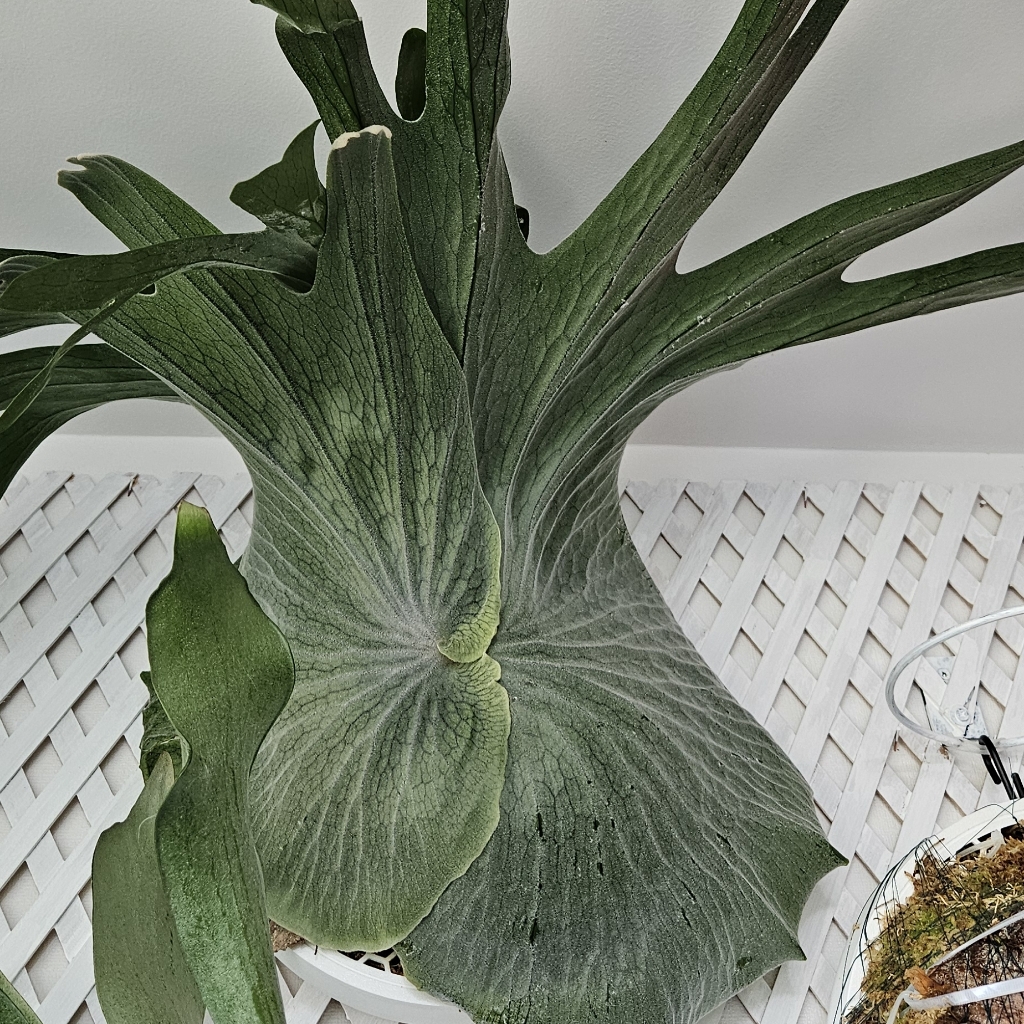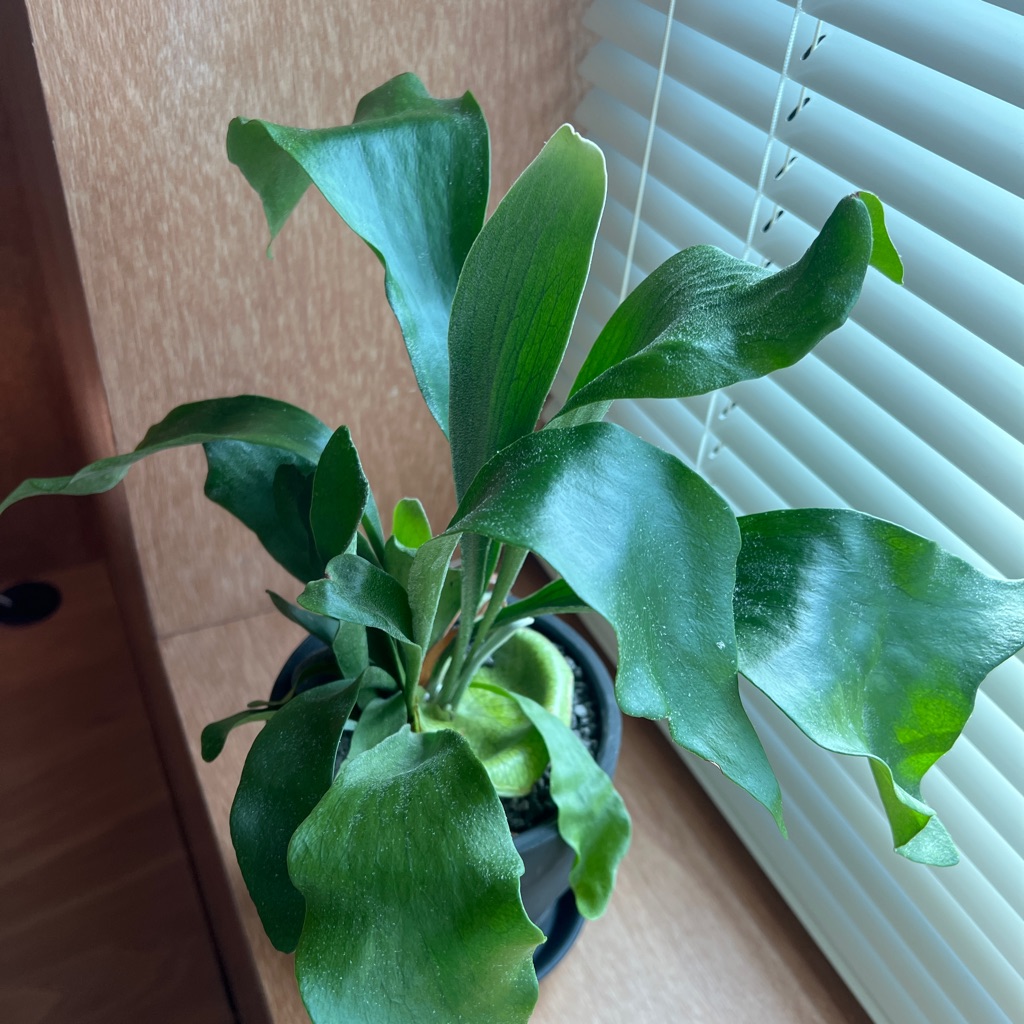How to grow and care for Platycerium superbum de Jonch. & Hennipman
plant care guide about watering, fertilizing, trimming, repotting, cutting, propagating Platycerium superbum de Jonch. & Hennipman, Superb staghorn
Platycerium superbum de Jonch. & Hennipman 101 - Plant Care Instructions
Bright indirect light
16C° ~24C°
Every 7 days
Growth Observation wiki
Botany Encyclopedia
Genus : Platycerium
🏝️ Habitat Conditions
This plant grows in tropical regions of South America and Southeast Asia. It prefers warm and humid environments. Since it grows attached to trees or rocks, it is better to receive indirect light for extended periods rather than direct sunlight.
🪨 Soil Mix
When planting, it's best to use well-draining soil. Typically, mix 40% potting soil, 20% bark, 20% leaf mold, 10% perlite, and 10% charcoal. However, the ratio can vary depending on the situation and environment. Besides soil, you can also plant in sphagnum moss, wood mounts, or moss.
🌡️ Environment
Maintain a temperature of 16-25°C, and keep it above 10°C in winter. Keep humidity at 50-70% and ensure good air circulation in humid conditions to prevent mold.
👀 Characteristics details
This plant has two types of leaves. The first type, called shield leaves, grows by wrapping around the base. Over time, they turn brown and decompose naturally, providing nutrients to the plant, so it's best not to remove them. The second type, called fertile leaves, grows upward to receive light. This plant is also great for interior decoration. It can be grown as a hanging plant by attaching it to a wooden mount or moss ball.
☀️ Light
Epiphytic plants prefer prolonged exposure to indirect light rather than direct sunlight.
💧 Water
For plants in soil, water them when the soil dries out. For plants in sphagnum moss or regular moss, water them before the moss completely dries out. If misting is insufficient, soak them in water to ensure they are well-watered.
🌱 Propagate
Typically, mature plants aged 3-5 years are propagated through spores or rhizomes. Propagation via rhizomes involves new shoots emerging from empty sections and growing. When these shoots reach about 30% of the parent plant's size, they can be separated for propagation. Propagation using spores is challenging and time-consuming but allows for obtaining many new plants. Spores form under the reproductive leaves and mature over 3-4 weeks. Once mature, they can be separated when they leave a residue upon touch. After separation, spread the spores evenly over sterilized peat moss in a large container. Keep the container sealed in a space with indirect light and maintain high temperature and humidity. Germination occurs in 2-3 months, appearing moss-like. Once true leaves appear, transplant them for further growth.
🪴 Repot
Repot healthy plants every 2-3 years in spring, as they do not grow quickly.
💊 Fertilize
Using fertilizer at the recommended amount during spring and summer can lead to more vigorous growth.
😵 Toxicity
Non-toxic and safe for pets and children.
water
How to water Platycerium superbum de Jonch. & Hennipman
How often should I water?
check Platycerium superbum de Jonch. & Hennipman Every 7 days if it needs water when it’s very cold (below 5℃), water less frequently
When do I need to water?
the top 2-3 inches of soil is dry
Light & Location
How much light does a Platycerium superbum de Jonch. & Hennipman need?

Bright indirect light
Grow light
Light preference
Platycerium superbum de Jonch. & Hennipman likes Bright indirect light, Grow light day. The brighter the space, the better this plant grows.
Check if there’s an optimal place in your house!
This plant prefers
2K ~ 10K lux to thrive!
0
20K~
2K
10K
Temperature
Natural habitat
-17
-17~40℃
45
Houseplants
-15
16~24℃
45
Plants that grow in the wild and those that grow indoors prefer different temperatures. If you grow Platycerium superbum de Jonch. & Hennipman at home, make sure the temperature is 16~24℃.
Humidity
Ideal humidity
0
40~70%
100
Platycerium superbum de Jonch. & Hennipman prefers humidity about 40~70%. If necessary, increase humidity by misting, humidifier.
Fertilize
Collective Knowhow
When should I fertilize?
Only when your plant is healthy
How frequently should I fertilize?
1-2 times in growing season. A pinch for a small pot.
Characteristic
The taxonomic classification of Platycerium superbum de Jonch. & Hennipman is as follows. - Kingdom: Plantae, Phylum: Tracheophyta, Class: Polypodiopsida, Order: Polypodiales, Family: Polypodiaceae, Genus: Platycerium, Species: Platycerium superbum
| Characteristic Name | Characteristic Value |
|---|---|
| Lifespan | Perennial |
| Taxonomy Name | Taxonomy Value |
|---|---|
| Phylum | Tracheophyta |
| Class | Polypodiopsida |
| Order | Polypodiales |
| Family | Polypodiaceae |
| Genus | Platycerium |
| Species | Platycerium superbum |
Is your plant sick?
Track what happened. We’ll let you know the cause and treatment shortly!





1:1 Expert Help
You’ll get professional feedback within 24 hours from an expert on our team.
feedback will include











